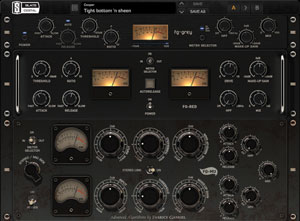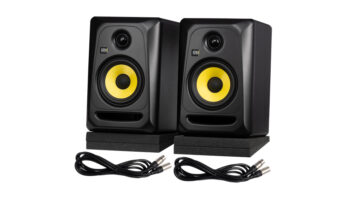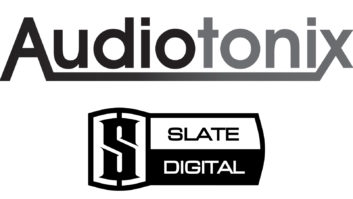
The VBC Rack contains three compressors that can be reordered, soloed or bypassed.
Many plug-ins that model vintage hardware strive to emulate the original item’s complete sonic and functional attributes, warts and all. Slate Digital’s Virtual Buss Compressors, on the other hand, cherry-picks the best and jettisons the rest. Each of the three compressors included in the bundle is either a modified model of a single hardware unit (attempting to improve its sound or function) or combines the best traits of various compressors to create a hybrid processor.
The bundle includes four plug-ins: Three contain a single bus compressor each, and the fourth lumps all three into a virtual rack for simultaneous use. Each component plug-in incorporates not only a model of a classic hardware unit’s compression curves, but also its harmonic- and phase-distortion behavior and noise—essential analog characteristics. Intended for processing mixes and tracks routed to a stereo aux bus (such as subgrouped drums), the plug-ins only operate in 2-channel configurations at the time of this writing.
I reviewed the AU version of Virtual Buss Compressors Version 1.0.1.6 in Digital Performer 8.04, using an 8-core Mac Pro running OS X 10.8.4. VST, RTAS and AAX formats are also offered. An iLok 2 dongle is required for operation.
Remodeled Classics
The FG-Grey plug-in models the SSL 4000 Series console’s bus compressor, but also incorporates the characteristics of Saint Ives transformers on its I/O. (Saint Ives transformers are famously used in dozens of Neve modules and consoles.) The virtual-transformer modeling purportedly adds presence and clarity to the midrange and preserves the bottom end when deep compression is applied. Unlike with the SSL hardware unit, the amount of gain reduction stays the same when you change the plug-in’s attack time, facilitating setup and A/B comparisons.
The FG-RED plug-in models the classic Focusrite RED 3 compressor, with some modifications. The original hardware increases compression depth rapidly with increased ratio settings above 1.5:1, making fine adjustments somewhat difficult. The ratio settings are more highly resolved in Slate’s plug-in, providing greater knob travel over the lower portion of the range. (A 6:1 ratio setting in the plug-in sounds like the 3:1 setting in hardware.) But perhaps the plug-in’s most noteworthy modification is the addition of a drive control, which models the saturation characteristics of the RED 3’s output transformer, so integral to the hardware’s vintage analog sound; unlike with the hardware unit, you don’t have to crank makeup gain in the plug-in to get transformer-saturation flavoring.
The FG-MU plug-in combines the attributes of Fairchild 670 and Manley Variable Mu tube compressors, along with traits of unspecified tube amps. Whereas FG-Grey and FG-RED can only operate in stereo mode, FG-MU offers dual-mono operation (with defeatable stereo linking) and a mid-side mode.
Each of the three compressors includes controls for attack and release times, threshold, makeup gain, variable highpass filter (in the sidechain) and wet-dry mix (enabling parallel compression). FG-Grey and FG-RED also each provide an auto-release and ratio control, whereas FG-MU controls compression depth by adjusting its input and threshold controls (consistent with vari-mu designs). VU-style metering—alternately displaying input, output and gain-reduction level—graces the lot. The VBC Rack plug-in lumps FG-Grey, FG-RED and FG-MU together in one GUI. Drag and drop the component compressors within the rack to change their order in the signal path. Each compressor can also be bypassed or soloed by respectively clicking or control-clicking its virtual power switch.
All four plug-ins offer A and B workspaces; you can copy control settings from one to the other. Presets can be saved and recalled, and banks of presets imported and exported.
Bus Ride
My first test of VBC was on a rockin’ country production. I had previously bounced a percussively strummed acoustic guitar track through an SSL 4000 Series bus compressor to level it, using the following settings: 10 ms attack, 0.1 sec release and 10:1 ratio. I set up FG-Grey on a bus for the original (unprocessed) stereo track, using the same compressor settings so I could compare the plug-in’s sound to that produced by the hardware. I adjusted FG-Grey’s threshold for 9 dB of gain reduction on peaks and an 8dB crest factor, similar to that achieved using the SSL hardware. The plug-in delivered a fantastic, in-your-face sound that was remarkably similar to that produced by the SSL bus compressor. That said, the SSL track had more detailed transients and greater depth. It’s important to keep in mind that this was not a real-time A/B comparison to hardware, and Slate didn’t try to exactly replicate the SSL’s sound. Bottom line: FG-Grey sounded much more like an SSL bus compressor than any other plug-in I’d heard to date. I was very impressed.
FG-Grey, with a 4:1 ratio selected, also sounded marvelous placed on a subgroup for drums. A moderate attack and fast release let just enough transients through to perfectly marry the traps’ punch to the room mics’ greatly magnified ambience. Raising the highpass filter’s corner frequency made the kick drum sound larger and less contained—great for a booming, aggressive sound.
Enlisting FG-Grey to apply 1 dB of gain reduction to a full mix—using a 4:1 ratio, slow attack and auto release—tightened up the bottom end a bit. But the 4:1 ratio also often caused previously contained peaks to clip my mix bus, even with no makeup gain applied. (My guess, based on past observations of other plug-ins that model tube gear, is this was probably due to modeled harmonic distortion added to the signal.) And even using the slowest attack, fastest release, 1.5:1 ratio and highest possible threshold, FG-Grey reduced the mix’s depth somewhat.
I got much better results using FG-RED to compress a mix. A-list mixer Chris Lord Alge contributed some terrific rock presets for this plug-in that tighten up the sound beautifully. Cranking the drive control imparts a sound somewhat reminiscent of an aural exciter; to keep the mix from sounding too edgy, I generally preferred setting the drive knob to 5.5 (on a scale of 1 to 10). But I also got excellent results slamming rock mixes with 4 to 7 dB of gain reduction, using maxed-out ratio and drive settings, and setting the mix control to only around 30 percent (that is, using very little of the processed signal).
FG-MU sounded absolutely superb on subgrouped drums. Fast attack and release times and 15 dB of gain reduction created a positively explosive sound. While I felt the compressor pumped too much to use on strummed acoustic guitar, its bright, bass-lean tone sounded great on this instrument with no compression applied. But on a full mix—with or without compression applied—bass frequencies were attenuated too much, undoing my carefully crafted bass-treble balance. Peaks were also heightened, compelling me to reduce the mix’s volume at least 2 dB to avoid clipping.
Global Considerations
Happily, I encountered no bugs during my review process. I regretted, however, that I couldn’t lock the plug-ins’ mix and threshold settings while auditioning different factory presets—a minor complaint. When using FG-Grey or FG-MU with a high threshold (for shallow compression) on your mix bus, you may want to put a brickwall limiter at the end of your signal chain to control their algorithms’ accentuated high-frequency transients. Otherwise, you’ll often likely need to lower the mix bus’ output level to prevent clipping, and that could make your mix sound too quiet (unless, of course, you intend to have the crest factor fixed in mastering).
FG-RED sounds splendid on mixes, while FG-Grey and FG-MU excel on subgrouped drums and bused guitars. None of the plug-ins are great tools for increasing the loudness of a mix; in fact, FG-Grey and especially FG-MU often increase crest factor. But what I love most about these compressors is, not only do they sound great on select applications, they also sound different than any other plug-ins currently available. Selling for only $249, Virtual Buss Compressors is a great buy.
Mix contributing editor Michael Cooper is a recording, mix, mastering and post engineer and the owner of Michael Cooper Recording in Sisters, Oregon.
Try This
In VBC Rack, set FG-Grey to 4:1 ratio, moderate attack time, auto release and bypassed highpass filter. Adjust the threshold for 1 dB of gain reduction. Place FG-RED next in the chain, and set its ratio to 1:1 (no compression) and its drive knob to 5.5. Bypass FG-MU. Your mix’s bottom end will become more focused and the top end will gain a subtle sheen.
Product Summary
COMPANY: Slate Digital
PRODUCT: Virtual Buss Compressors
WEBSITE:slatedigital.com
PRICE: $249
PROS: Sounds great (on select applications). Unique. Compressors can be reordered and independently bypassed or soloed in VBC Rack. Low price. No evident bugs.
CONS: Some FG-Grey and especially FG-MU setups increase crest factor. Can’t lock mix or threshold control while browsing presets.







